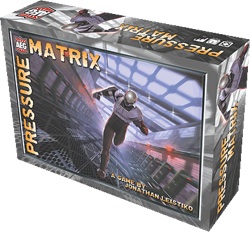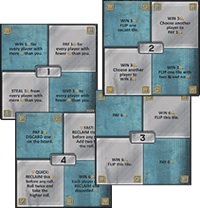
|
About OgreCave and its staff
|

|
by Lee Valentine
Pressure Matrix is the second game by Jonathan Leistiko that has been published by Alderac Entertainment Group. In Pressure Matrix, runners in a futuristic game show race around a game board tagging specific points which generate either bonuses or penalties for the runner (or his competitors). The one with the most credits (i.e., money) at the end of the game show is declared the winner. Contrary to what the above description may lead you to believe, this is not a boardgame version of The Running Man – nobody is chasing anyone with an electrical blaster or a chainsaw. You can block other runners, occasionally force them to move to specific squares, and often make them lose some credits, but that is about the level of threat potential to the runners in the Pressure Matrix. Other than the box's cover art and some runner miniatures, the game is entirely abstract in nature.
Gameplay
When a player lands on his destination tile he chooses one of the four spaces on the tile he lands on, places a Blackout Marker on the space in question, and carries out the game text there, which is typically something like "Win 3 credits" or "Give another player 3 credits". Subject to other specialized game effects, any space that is blacked out can no longer be activated by anyone who lands on that tile in the future. Each player has five triangular Control Markers to spend during the game (plus a sixth used to track your score). Some special game spaces are not activated immediately when they are blacked out, but are instead blacked out and marked with a Control Marker. The player who owns that Control Marker can later retrieve it to trigger the associated effect when he needs it. These specialized effects can, for example, force the dice to be re-rolled or modified or may even allow a character to teleport from one space on the board to another. If all four spaces on a tile are blacked out then generally runners can no longer pass through that tile. Between this rule, the dice rolled, and the position of other board runners, a player may have many different tiles to chose from, a few, one, or even none. When a player has no legal moves based on his dice roll and the board configuration then he is "frozen" and must return one of his Control Markers in hand to the box. If a player has no Control Markers in hand when it's his turn to roll for movement, the game ends. The winner is the player who banked the most credits over the course of play (although players do get one bonus credit for each unused Control Marker remaining in hand at the end of the game). Each time all four spaces on a tile get blacked out, the pressure level moves to yellow. If a runner is frozen, the pressure level immediately escalates one level (from green to yellow, or from yellow to red). Other game effects can raise or lower the pressure level. So, as the game progresses and things become more congested, it is to the score leader's advantage to drive up the pressure level, forcing people to become frozen, run out of Control Markers, and end the game. There are 50 double-sided Matrix Tiles to choose from when building the board, so each game will be different. Because the board is randomly built, sometimes the selection of game effects will be fairly singular in theme – almost every space you land on will cause you to lose money. In other games, options like teleportation, stealing money, and passing through otherwise blocked tiles become options. Sometimes the board allows for more significant strategy. At other times, however, you end up with powers that allow the player in last place a 50% chance to exchange scores with the leader if he lands on the right tile, draining any serious long-term strategy out of the game when that happens. The board size varies based on the number of players, and this directly impacts the number of choices for each move as well as partially determining the length of the game. A two-player game (which is played on a smaller board) can last 20 minutes, while a three-player game can last up to an hour. Occasionally there's some down time during another player's turn if he has a lot of movement options and feels obliged to read every space on every tile he can potentially land on.
Components & Packaging There is also a nice thick score board that is used to track score from round to round, featuring pictures of numbered gold coins (credits). This has part of the box art image on it, giving it a little more theme than the tiles themselves. The box has an insert tray to hold the five runner miniatures that come in the game. Oddly, the pictures of the runners in the rulebook have different poses and color schemes than those of the actual miniatures. Two of the colors for runners are orange and yellow, but the shades chosen are so similar to each other that players might get each other's miniatures confused in a five-player game. There is a small insert to hold the Control Markers, but it will not securely hold the mountain of Blackout Markers that come with the game. Nor does the box segregate the tiles to hold them securely. Thankfully there was enough space in the box for me to bag the tokens in gripseal bags to separate them and pack them away. The rulebook was full-color, glossy, and well-written overall. I had only one or two questions after reading it, and they were minor at best.
Conclusions This game sits in an odd niche. As a two-player game it plays like a short filler game with some light tactical choices. Longer-term strategic choices exist only if you see a trick your opponent doesn't and you are lucky enough to land in the right places at the right times. As a three-player game there are more options, but the game can sometimes run a little long for what it is, depending on the tile selection being played with. I have not tried the game with four or five players. If there is any deep thinking, most of it is positional (knowing how to block your opponents and freeze them). The rest of the decision-making is often quite transparent – would you rather win 5 credits or pay someone else 3? When the board features specific options to control the pressure level then the strategy is increased, but not all the tiles allow for this option. Once the pressure level is turned up to red, particularly late in the game, strategy is often reduced to near nil (unless you have stored Control Marker powers) as players often end up frozen. This would be a tougher game to play under tight time pressure (like that provided by a sand timer), but there was no such time keeping mechanism provided with the game. I do not feel that there is enough meat to this game for adult gamer geeks, and perhaps a bit too much counting and reading for an adult party game. As one of my friends, Joseph Gagnepain observed, it looks like the kind of game I might have enjoyed when I was ten or twelve years old. That is not to disparage the game in the slightest. I think this is a fine game for parents to play with their kids, and I can recommend it for those readers raising the next generation of gamers. It will do a fine job teaching counting, spacial relations, reading, and quick decision-making. For adults, however, I suspect that this is not going to go over as well with your gaming group as Small World or Pandemic. If you want to play Pressure Matrix with that crowd, buy a sand timer, play with more people on a bigger board, and watch people sweat, begging for more time to read the board – then you may feel some actual pressure.
For Retailers
Lee's Ratings:
Links:
|
||
 Pressure Matrix
Pressure Matrix At its core, Pressure Matrix is an elevated roll-and-move game.
The game has three levels of "pressure" on the runners: green (walking),
yellow (jogging), and red (running). On a player's turn he rolls three
dice to determine his movement distance. At the green level he moves
the number of tiles listed on the lowest die. If the pressure level is
yellow he moves the value shown on the unmatched die if two of the dice
tie, or otherwise moves the value of the middle die. If the pressure
level is red the runner moves the value of the highest of the three dice
rolled. Movement is orthogonal, and you cannot enter a tile occupied by
another runner or re-enter a tile that you have previously touched on
that same turn. You always have to move the full value of the movement
die if you can.
At its core, Pressure Matrix is an elevated roll-and-move game.
The game has three levels of "pressure" on the runners: green (walking),
yellow (jogging), and red (running). On a player's turn he rolls three
dice to determine his movement distance. At the green level he moves
the number of tiles listed on the lowest die. If the pressure level is
yellow he moves the value shown on the unmatched die if two of the dice
tie, or otherwise moves the value of the middle die. If the pressure
level is red the runner moves the value of the highest of the three dice
rolled. Movement is orthogonal, and you cannot enter a tile occupied by
another runner or re-enter a tile that you have previously touched on
that same turn. You always have to move the full value of the movement
die if you can.